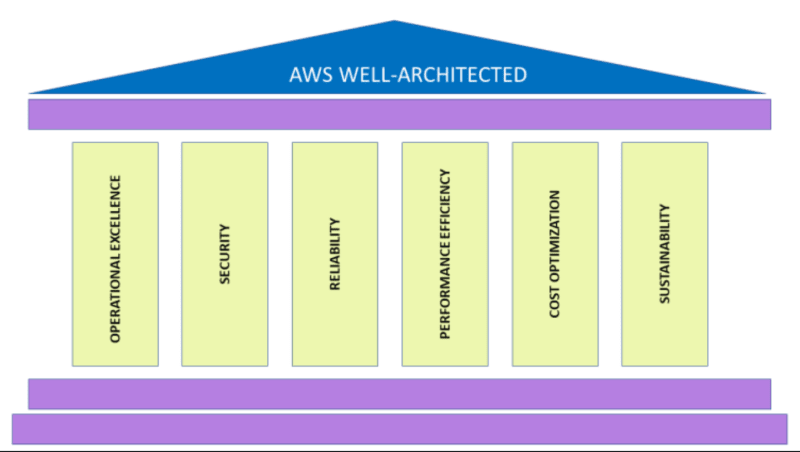Would you like to maximize the potential of cloud-based applications? This article on this Monday provides an in-depth exploration of the framework’s pillars, focusing on operational excellence and security best practices. By following these principles, businesses can ensure the effective operation, security, cost optimization, and scalability of their applications. The foundational principles of AWS’s well-architected framework play a crucial role in the successful design and management of cloud-based applications. Strong architecture allows organizations to harness the full potential of cloud-based solutions, providing a competitive edge in the market.
Well, what are the issues to be considered in this regard? Let’s dive into this briefly:
Learn the pillars of the well-architected framework on AWS
i- Operational excellence pillar focuses on improving processes and procedures to deliver value to your business: The AWS well-architected framework aims to enhance service quality and increase efficiency through the optimization of operational processes. This can help your business provide better services to customers and gain a competitive advantage.
ii- Best practices include performing operations as code and making frequent small and reversible changes: This is a component of operational excellence, which is part of the AWS well-architected framework. Performing operations as code increases automation and ensures consistency. Making frequent small and reversible changes improves application flexibility and enhances error correction processes. These approaches can help your business operate more efficiently and reliably.
Prevent and recover from failure
i- Refine operational procedures frequently: The comprehensive architectural framework offered by AWS embraces a philosophy of continuous improvement and optimization. Regularly reviewing operational procedures enables the creation of more effective and efficient business processes. This enhances service quality and supports the achievement of operational excellence for the business.
ii- Anticipate and learn from all operational failures: The well-architected framework provided by AWS embraces a philosophy of continuous improvement and learning. Anticipating and learning from operational failures helps prevent the recurrence of similar errors in the future. This supports the business in continuously improving and progressing towards operational excellence.
Automate security best practices
i- Apply security at all layers: The AWS well-architected framework emphasizes that security is a fundamental component. Implementing security measures at all layers of the application ensures the protection of systems and data. This includes authorization, access control, encryption, and other security measures. A robust security implementation helps prevent data breaches, unauthorized access, and other security vulnerabilities.
ii- Protect data in transit and at rest: It is crucial to encrypt and protect data both during communication and while stored. Encryption during communication ensures the protection of data from unauthorized access. Encryption and other security measures are also utilized to secure data in situations where it might be intercepted. This is essential to ensure the safety of sensitive information.
Reliability pillar ensures consistent workload performance and automated recovery
i- Automated recovery is crucial for minimising downtime and ensuring workload consistency: The comprehensive architectural framework offered by AWS aims to utilize automated recovery mechanisms and ensure rapid restoration of workloads. Automated recovery enables the automatic restart and return to normal operations of workloads in the event of system failures, disruptions, or other adverse events. This improves customer experience and ensures business continuity.
ii- Testing recovery procedures is important to ensure they work when needed and scaling horizontally increases workload availability: The AWS well-architected framework recommends testing recovery procedures to ensure their proper functioning. This is done to validate that the recovery processes will effectively come into play in error situations and ensure the protection of data and systems. Additionally, horizontal scaling enhances workload availability. Scaling the workload horizontally provides better responsiveness to increased demands and offers a high level of availability.
Scaling horizontally in the cloud prevents individual component failure from affecting the overall application
i- Multi-AZ failover and horizontal scaling are options for preventing failure in larger instance sizes: The comprehensive architectural framework offered by AWS provides solutions for failure scenarios that may occur in systems with larger instances. Multi-AZ failover ensures high availability by replicating backups across multiple availability zones. Horizontal scaling, on the other hand, enables the expansion of resources to respond to increased workload demands and improve system performance. These options can be utilized to ensure more reliable and high-performance operation of systems.
ii- The cloud allows for dynamic and automatic resource allocation, eliminating the need for guessing capacity and easily managing change: The well-architected framework provided by AWS emphasizes that resources can be dynamically allocated through cloud computing infrastructure. This enables automatic scaling of resources based on workload and adjustment to the required capacity. The cloud infrastructure also eliminates the need for resource forecasting as resources are automatically adjusted when needed. This enables more efficient resource utilization and enables the workload to easily adapt to changing needs.
Automate and leverage AWS services for efficient resource management
i- Utilize AWS tools such as managed services, event-driven architectures, and serverless services: The AWS well-architected framework offers various services to efficiently manage workloads and reduce infrastructure-related responsibilities. Managed services are services that are managed and maintained by AWS, allowing businesses to run their applications quickly and securely with less management overhead. Event-driven architectures enable workloads to operate flexibly and scale in response to events. Serverless services provide the ability to run code without the need to manage infrastructure.
ii- Deploy applications globally and use serverless architectures to avoid managing underlying infrastructure: The well-architected framework provided by AWS encourages the global distribution of applications and their operation in close proximity to users. Globally distributed applications result in low latency and enhanced user experience. Serverless architectures eliminate the need for managing infrastructure. Instead of managing the infrastructure, developers upload their code and run it as a service that is automatically scaled and managed by AWS.
AWS best practices include experimentation, mechanical sympathy, and cost optimization
i- Experimentation allows for learning and improvement through testing different things in the cloud: The cloud environment provides a suitable platform for rapid prototyping, A/B testing, and other experiments. Experimentation is important for testing new ideas, evaluating performance, and continuously learning. In this way, businesses can leverage the flexibility and scalability offered by the cloud to develop better solutions and continuously improve themselves.
ii- Mechanical sympathy means understanding available systems to utilize them effectively, and cost optimization involves delivering value at the lowest price point through cloud financial management and measuring efficiency: The AWS well-architected framework emphasizes the understanding and effective utilization of existing systems by businesses. Mechanical empathy means selecting the most suitable services for workloads, efficiently utilizing resources, and optimizing performance. Cost optimization aims to deliver value at a low cost through cloud financial management. This enables the efficient use of resources, prevents unnecessary costs, and allows businesses to develop solutions that align with budget and performance goals.
AWS recommends focusing on high-value tasks instead of managing infrastructure
i- Stop spending money on undifferentiated heavy lifting: The comprehensive architectural framework offered by AWS emphasizes that businesses should avoid unnecessary expenses associated with performing non-differentiating, standard, and repetitive tasks. Undifferentiated heavy lifting refers to operational tasks that do not provide a competitive advantage and often include activities such as data center management, hardware procurement, and infrastructure maintenance. By leveraging AWS’s managed services and automation capabilities, businesses can avoid unnecessary expenses associated with performing these types of tasks and focus their resources on areas that drive differentiation.
ii- Concentrate on developing better features and applications for your customers to differentiate your business. Analyze and attribute expenditure to understand costs:The well-architected framework provided by AWS encourages businesses to develop superior features and applications tailored to customer needs in order to gain a competitive advantage. It is important for businesses to adopt a customer-centric approach and provide solutions that deliver value to their customers. Additionally, it is necessary to analyze expenditures in order to understand costs. This analysis helps in understanding how expenses are allocated to resources and how much investment the business is making in different areas. These analyses enable effective utilization of resources and allow the business to align with budget and strategic goals.
Conclusion
The AWS Well-Architected Framework empowers businesses to unlock the full potential of cloud-based applications. By adopting its principles and pillars, organizations can design, manage, and optimize their applications for operational excellence, security, cost efficiency, and scalability. Embracing this framework allows businesses to stay ahead of the competition, deliver value to their customers, and thrive in the ever-evolving landscape of cloud computing.
#AWSWellArchitectedFramework #CloudBasedApplications #OperationalExcellence #SecurityBestPractices #OperationalProcesses #ServiceQuality #Efficiency #OperationalFailures #ContinuousImprovement #Learning #SecurityMeasures #Authorization #AccessControl #Encryption #DataProtection #Reliability #WorkloadPerformance #AutomatedRecovery #DowntimeMinimization #WorkloadConsistency #TestingProcedures #HorizontalScaling #WorkloadAvailability #MultiAZFailover #ResourceAllocation #CapacityPlanning #InfrastructureManagement #AWSManagedServices #EventDrivenArchitectures #ServerlessServices #GlobalDeployment #CostOptimization #Experimentation #MechanicalSympathy #CloudFinancialManagement #EfficientResourceManagement #InfrastructureMaintenance #ValueDelivery #CustomerCentric #Differentiation #CostAnalysis




